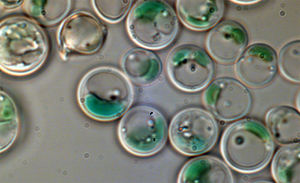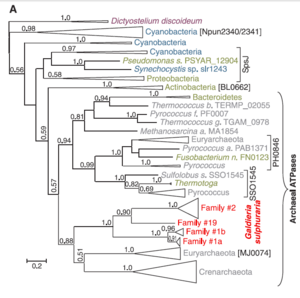Galdieria sulphuraria

Classification
Domain: Eukaryota; Class: Rhodophyta; Family: Cyanidiaceae; Genus: Galdieria
Species
Species: Galdiera sulphuraria
Description and Significance
Galdieria sulphuraria is a eukaryotic, spore-forming, coccus. G. sulphuraria appears yellow-green to dark blue-green grown heterotrophically in liquid culture, and often yellow or green in its natural environment. It is an acidophile, as well a thermophile, and inhabits highly acidic springs at high temperatures.
G. sulphuraria is a mixotrophic organism capable of both photosynthesis and the catabolism of a wide variety of metabolites.
Genome Structure
Phylogenetic and genomic analyses supplied by, Gerald Schönknecht et al. revealed 75 indications of horizontal gene transfer from archaea and bacteria along with highly condensed protein coding regions within the G. sulphuraria genome[6]. It is speculated that minimally 5% of the functional genes were acquired in this way [1]. Success of G. sulphuraria in a variety of extreme habitats is apparently facilitated by the acquisition and subsequent duplication of heat tolerant archael ATPases, halophilic sodium-proton antiporters and arsenical membrane protein pumps genes of acidophilic bacteria along with a other highly derived genes [6].
Cell Structure, Metabolism and Life Cycle
"presents a vacuole, a multilobed chloroplast and a net-like mitochondrion" [2]
"This alga shows an enormous metabolic flexibility, growing either photoautotrophically or heterotrophically on more than 50 carbon sources" [3]
Ecology

"The unicellular red micro-alga Galdieria sulphuraria (Cyanidiales) is a eukaryote that can represent up to 90% of the biomass in extreme habitats such as hot sulfur springs with pH values of 0 to 4 and temperatures of up to 56°C." [4]
"Some microbial eukaryotes, such as the extremophilic red alga Galdieria sulphuraria, live in hot, toxic metal-rich, acidic environments" [5]
References
[1] http://link.springer.com/content/pdf/10.1007%2Fs00253-007-1150-2.pdf
[2] http://link.springer.com/content/pdf/10.1023%2FA%3A1004035224715.pdf#page-1
[3] http://www.ncbi.nlm.nih.gov/pubmed/23471408
[4] http://genomics.msu.edu/galdieria/about.html
[5] http://www.ncbi.nlm.nih.gov/pubmed/23471408

